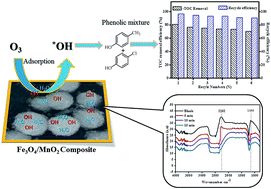Insights into the mechanism of phenolic mixture degradation by catalytic ozonation with a mesoporous Fe3O4/MnO2 composite
Abstract
A mesoporous Fe3/MnO2 composite was fabricated by a co-precipitation method in this paper, and it showed a much higher activity than Fe3O4 and MnO2 in the catalytic ozonation of a p-cresol and p-chlorophenol mixture. The physicochemical properties of Fe3O4 and MnO2 and Fe3O4/MnO2 were compared using XRD, SEM, TEM and N2 physical adsorption/desorption. pH had a significant effect on the degradation rate of the phenols and catalyst stability, and the degradation order of p-cresol and p-chlorophenol also varied in different mediums. pH 9 was found to be the optimal condition both for catalytic activity and metal leaching. Attenuated total reflection Fourier transform infrared spectra confirmed that ozone replaced chemically adsorbed water on the Fe3O4/MnO2 surface and evolved into reactive radicals. Electron spin resonance and quenching experiments with different scavengers were conducted to reveal that the hydroxyl radicals were mainly responsible for the phenolic mixture degradation at pH 9, along with a little contribution of singlet oxygen and molecular ozone. A detailed mineralization pathway of the phenolic mixture was also proposed according to the gas chromatography-mass spectrometry results.


 Please wait while we load your content...
Please wait while we load your content...